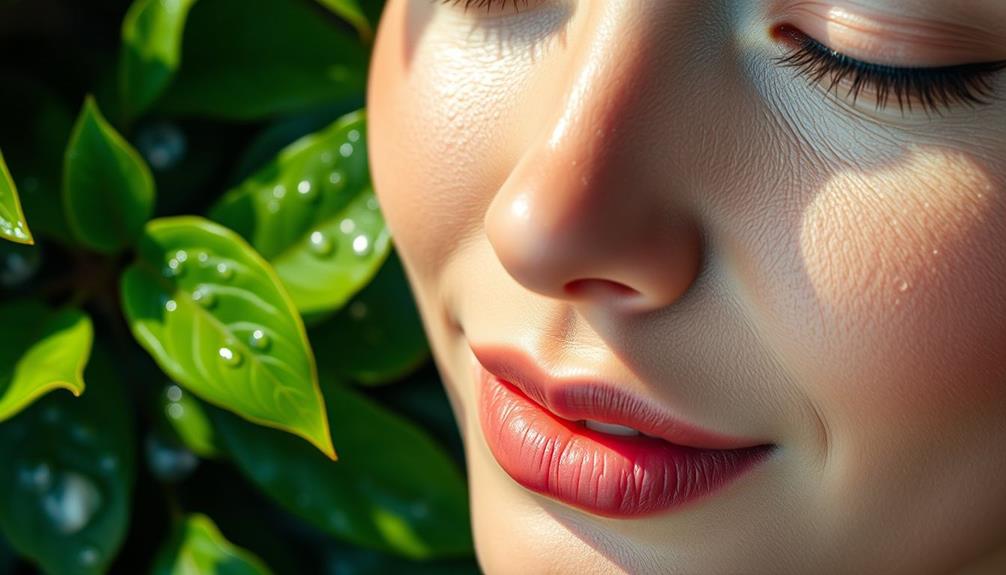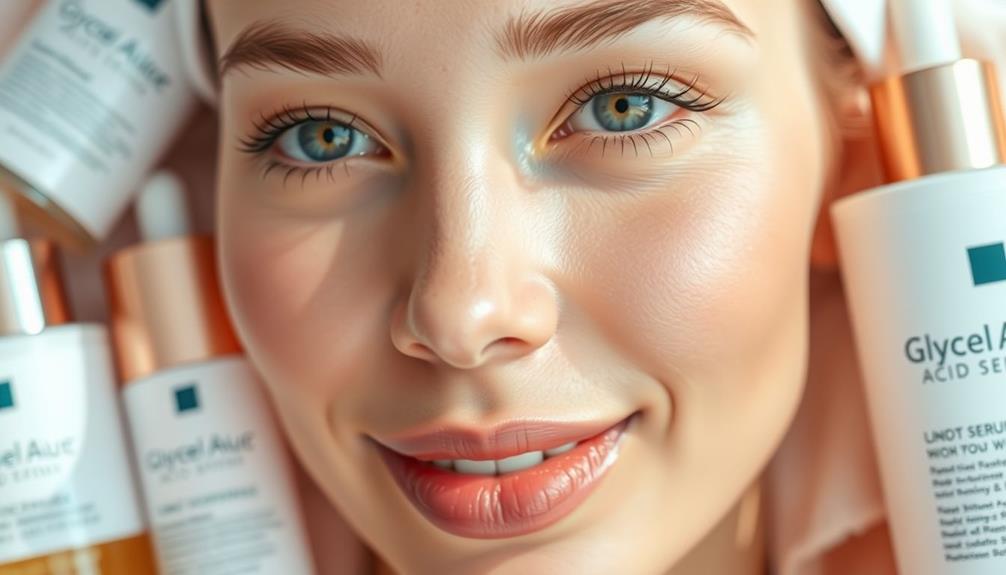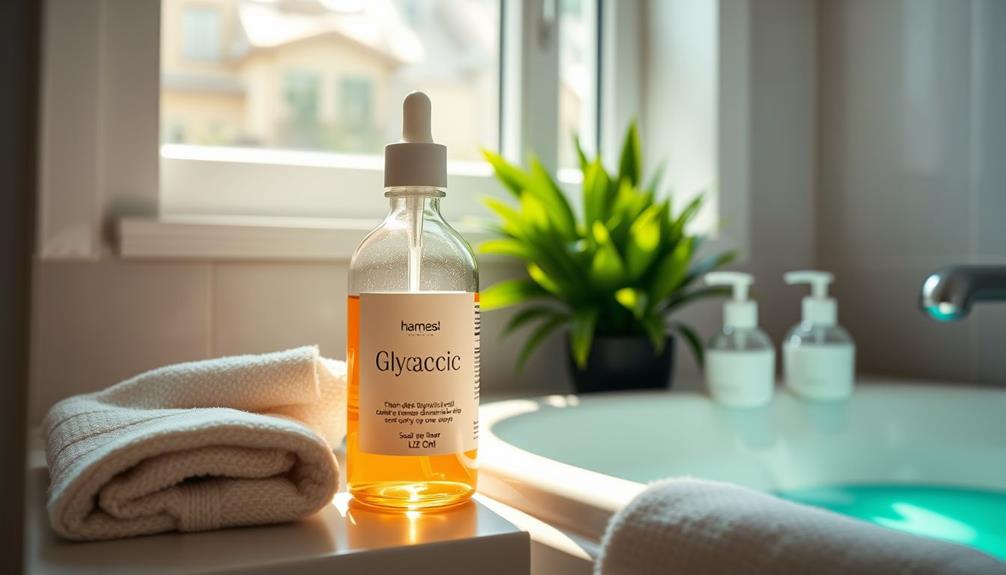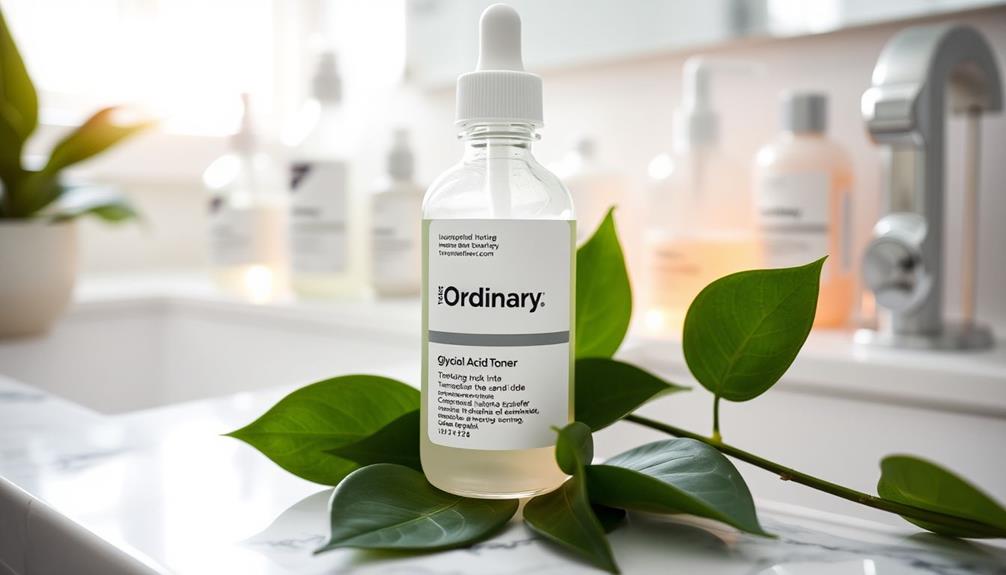Glycolic acid's impact on your face can be impressive. This alpha-hydroxy acid exfoliates and promotes cell turnover, leaving your skin smoother and brighter. It also boosts collagen production, which helps reduce fine lines and improves elasticity. The ingredient attracts moisture, enhancing hydration and giving your skin a revitalized glow. Additionally, regular use can lighten dark spots and improve overall texture. However, starting with a lower concentration is essential to avoid irritation. If you're curious about specific products or treatment options, there's much more to discover that can help tailor your skincare journey.
Key Takeaways
- Glycolic acid enhances skin texture by promoting cell turnover and exfoliating dead skin cells for a smoother complexion.
- It stimulates collagen production, helping to reduce the appearance of fine lines and wrinkles, thus offering anti-aging benefits.
- As a humectant, glycolic acid attracts moisture to the skin, improving hydration levels and preventing dryness.
- Regular use can help fade dark patches and improve overall skin tone, addressing issues like hyperpigmentation.
Glycolic Acid Explained

Glycolic acid, an alpha-hydroxy acid derived from sugar cane, excels at exfoliating your skin thanks to its small molecular size, which allows it to penetrate deeply. This unique property enhances its exfoliating capabilities, helping to dissolve dead skin cells on the surface.
As a result, you'll notice improved cell turnover, leading to a brighter and smoother skin texture over time. Incorporating glycolic acid into your skincare routine can also stimulate collagen production, which is essential for maintaining skin elasticity and reducing the appearance of fine lines and wrinkles.
Additionally, the use of essential oils, such as lavender or tea tree oil, can complement your skincare routine by promoting relaxation and supporting skin health therapeutic benefits of essential oils.
Whether you choose over-the-counter skincare products or opt for professional treatments, the concentration of glycolic acid typically ranges from 5% to 20%. Higher concentrations are often reserved for more intensive exfoliation during professional sessions.
Additionally, glycolic acid is effective for fading dark spots and addressing sun damage. While it may not completely erase scars, it can soften their appearance, making your skin look more even.
With regular use, you'll find that glycolic acid not only enhances your skin's texture but also boosts your overall complexion.
Key Benefits for Skin

Key Benefits for Skin
When you use glycolic acid, you'll notice its powerful anti-aging properties that help smooth fine lines and wrinkles.
It also enhances hydration levels, leaving your skin plumper and more youthful.
Additionally, glycolic acid improves skin texture by promoting cell turnover, giving you a radiant complexion. The science behind glycolic acid lies in its ability to break down the bonds between cells, allowing for the sloughing off of dead skin cells and revealing the newer, smoother skin underneath. This process also stimulates the production of collagen and elastin, which are essential for maintaining skin firmness and elasticity. This overall improvement in skin texture can help diminish the appearance of fine lines, wrinkles, and uneven pigmentation, leaving you with a more youthful and glowing complexion.
Incorporating essential oils like lavender oil can further enhance your skincare routine by promoting relaxation and reducing stress, which are also beneficial for skin health.
Anti-Aging Properties
Harnessing its potent anti-aging properties, glycolic acid effectively stimulates collagen production, helping to smooth out fine lines and wrinkles for a more youthful appearance.
As you incorporate glycolic acid into your skincare routine, you'll notice significant improvements in skin texture due to its ability to promote cell turnover. This process reveals smoother, firmer skin while also reducing the visibility of dark spots and uneven skin tone caused by sun damage.
Additionally, incorporating ingredients like vitamin-rich extracts can further elevate your skincare regime and enhance health benefits of juicing.
Glycolic acid works wonders against photoaging by reversing signs of skin damage and enhancing your overall complexion.
Regular use allows you to maintain a brighter, more even skin tone, giving you that radiant glow.
Furthermore, as glycolic acid boosts collagen production, it helps to plump your skin, contributing to a youthful and fresh look.
Enhanced Hydration Levels
You'll find that enhanced hydration levels from glycolic acid can greatly improve your skin's overall moisture balance and texture. This powerful ingredient acts as a humectant, attracting water molecules to your skin, which helps to improve hydration. Regular use can boost hyaluronic acid levels, increasing your skin's ability to retain moisture and achieve a plump, well-hydrated appearance.
Glycolic acid also promotes cell turnover, allowing fresh, hydrated skin cells to replace older, dehydrated ones. By exfoliating dead skin cells, it prevents dryness and flakiness that can detract from your skin's natural glow. As your hydration levels increase, you'll notice a more youthful appearance, as well-hydrated skin is less prone to fine lines and wrinkles.
Incorporating glycolic acid into your routine can transform your skin by ensuring a healthy moisture balance. As you experience improved hydration, you'll likely find that your skin feels softer, looks smoother, and radiates energy.
Embrace glycolic acid for a more hydrated complexion and enjoy the benefits of rejuvenated, youthful skin.
Improved Skin Texture
Glycolic acid transforms skin texture by promoting cell turnover and refining the surface, leaving you with a smoother and more radiant complexion. Its powerful exfoliating properties dissolve the bonds between dead skin cells, effectively revealing fresher skin underneath. This process not only enhances improved skin texture but also helps to reduce the appearance of fine lines and wrinkles, giving your skin a more youthful look.
By encouraging cell turnover, glycolic acid also aids in unclogging pores, which can greatly decrease acne breakouts and minimize enlarged pores. As a result, you'll notice a clearer complexion over time.
Additionally, glycolic acid boosts skin hydration by increasing hyaluronic acid levels, contributing to a plumper appearance.
Another key benefit is its ability to fade dark patches and even out skin tone, addressing sun damage and hyperpigmentation. With consistent use, glycolic acid can help you achieve a more uniform and luminous skin texture.
Scars and Glycolic Acid

When it comes to treating scars, glycolic acid can lighten dark patches and improve the overall appearance of your skin.
However, it won't completely remove scars, and its benefits are limited compared to more intensive treatments.
Regular use can help with skin cell turnover, but you might want to contemplate professional options for more significant results.
Glycolic Acid Efficacy
How effective is glycolic acid in reducing the appearance of scars on your skin?
Glycolic acid can help lighten dark patches and improve overall skin texture, making scars less noticeable over time. This alpha-hydroxy acid promotes cell turnover, which aids in healing and rejuvenating the skin.
While topical products containing glycolic acid can be beneficial, professional glycolic acid peels—formulated with higher concentrations of the acid (30% to 70%)—often yield more significant results for scar treatment.
However, it's essential to understand that glycolic acid won't completely eliminate scars. It can soften the appearance of raised and pitted scars, but for those with more severe scarring, alternative treatments might be necessary.
Individual results can vary based on your skin type and condition, so it's wise to consult a dermatologist to determine the best approach for your specific needs.
Regular use of glycolic acid can lead to an overall improvement in skin appearance, but patience is key, as noticeable changes may take time. Incorporating glycolic acid into your skincare routine can be a valuable step in managing scars and enhancing your skin's overall look.
Treatment Limitations
Despite its benefits, glycolic acid has limitations in treating scars, as it can't fully eliminate raised or pitted ones. While it's effective in lightening dark patches and improving skin texture, its primary role is to promote skin renewal rather than complete scar removal. You might find that professional glycolic acid peels yield better results compared to at-home products, yet they won't completely erase your scars.
| Treatment Type | Effectiveness | Considerations |
|---|---|---|
| Glycolic Acid | Lightens and improves texture | Limited on raised/pitted scars |
| Professional Glycolic Peels | Better results for scars | Requires multiple sessions |
| Alternative Treatments | More effective for reduction | Microneedling or laser therapy |
| Personalized Treatment Plans | Tailored to individual needs | Varying responses to glycolic acid |
If you're looking for significant scar reduction, consider exploring alternative treatments. Personalized treatment plans are essential, as individual responses to glycolic acid can vary. Understanding these limitations will help you set realistic expectations when it comes to your scar treatment journey.
Safe Usage Guidelines

To safely incorporate glycolic acid into your skincare routine, start with a low concentration of around 5% and apply it 2-3 times a week to gauge your skin's tolerance. This approach allows you to monitor for reactions, such as redness or skin irritation.
If you have sensitive skin, it's especially important to proceed with caution. Always conduct a patch test before applying glycolic acid widely to identify any adverse reactions.
Once you determine your skin can handle it, you can gradually increase the frequency of application. Remember to apply glycolic acid in the evening to minimize sun sensitivity, and don't forget to follow up with a broad-spectrum sunscreen during the day. This practice will help protect your skin from UV damage while using glycolic acid.
Avoid using glycolic acid in conjunction with other potent exfoliants like retinoids or beta hydroxy acids, as this can lead to irritation and compromise your skin barrier. Always listen to your skin and adjust the frequency as needed.
If irritation occurs, reduce how often you use it, ensuring a safe and effective skincare regimen.
Available Products and Treatments

Glycolic acid products come in various forms, such as cleansers, toners, serums, and masks, making it easy to find the right fit for your skincare routine. You'll find many over-the-counter options typically containing up to 10% glycolic acid, perfect for at-home use. If you're looking for more intensive exfoliation, professional treatments like chemical peels can offer concentrations ranging from 30% to 70%, performed at medical spas or dermatology clinics.
When choosing glycolic acid products, consider your skin type and tolerance. Brands like Exuviance provide formulations tailored to different concerns, guaranteeing you select the right concentration. It's key to incorporate products that include hydrating ingredients, such as hyaluronic acid, to counteract any potential irritation from the exfoliation process.
Before diving in, always conduct patch testing to verify compatibility, especially if you have sensitive skin. This precaution helps reduce the risk of adverse reactions and allows you to enjoy the benefits of glycolic acid safely. With the right approach, you can enhance your skincare routine and achieve smoother, more radiant skin.
Research and Evidence

Many studies support the effectiveness of glycolic acid in enhancing skin health by reducing signs of aging and improving overall texture. Research shows that glycolic acid stimulates collagen production, which helps reduce fine lines and wrinkles. When used at concentrations between 5% to 20%, it effectively improves skin texture and hydration for various skin types.
A randomized trial highlighted that 20% glycolic acid can also treat acne, promoting clearer skin by exfoliating dead skin cells. Additionally, glycolic acid is beneficial in addressing hyperpigmentation issues, like melasma. While it's particularly effective for surface-level dark patches, it may be less effective for deeper dermal melasma.
Long-term use of glycolic acid has been associated with sustained improvements in skin health, including increased elasticity and reduced hyperpigmentation. These findings are reinforced by multiple peer-reviewed articles.
Frequently Asked Questions
What Effect Does Glycolic Acid Have on the Face?
Glycolic acid helps your skin by promoting cell turnover, reducing fine lines, and fading dark spots. It unclogs pores, hydrates, and improves texture, giving you a smoother, more even complexion with regular use.
What Are the Bad Side Effects of Glycolic Acid?
Imagine your skin feeling tight and red after applying glycolic acid. It can cause irritation, sun sensitivity, peeling, and even hyperpigmentation. If you're not careful, it might lead to more harm than good for your complexion.
What Should You Avoid After Glycolic Acid?
After using glycolic acid, avoid direct sun exposure, strong exfoliants, hot showers, and irritating products like fragrances. Give your skin time to recover; it's sensitive and needs care to prevent irritation and enhance benefits.
How Do You Know if Glycolic Acid Is Working?
Are you noticing smoother skin, fading dark spots, or fewer breakouts? If so, glycolic acid's likely working for you. Consistent use shows results like brighter skin and improved texture—so keep it up!
Conclusion
In the grand circus of skincare, glycolic acid is the daring tightrope walker, balancing between exfoliation and irritation.
You're tempted to cheer for its benefits—smooth skin, even tone, and fewer scars—but watch out! Overdo it, and you might find yourself a contestant in the "Red Face Challenge."
So, embrace this acid with caution, like a magician with a loaded wand.
With the right approach, you'll leave the show with a radiant glow instead of a fiery fiasco!









